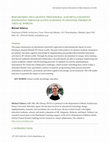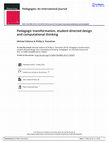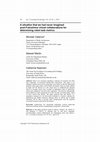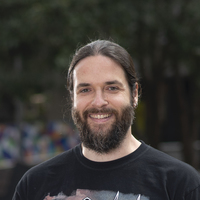Papers by Michael Vallance
25th ACM Symposium on Virtual Reality Software and Technology, 2019
Conventional hand-tracking devices are constructed with inertial measurement units, bending senso... more Conventional hand-tracking devices are constructed with inertial measurement units, bending sensors, and optical technologies. However, these are limited by their high-cost and environmental factors. In this research, a hand-tracking device using a tangential force mechanical sensor for use in Immersive Virtual Environments is proposed.

International Journal of Virtual and Personal Learning Environments
Recently, virtual reality (VR) technologies have developed remarkably. However, some users have n... more Recently, virtual reality (VR) technologies have developed remarkably. However, some users have negative symptoms during VR experiences or post-experiences. Consequently, alleviating VR sickness is a major challenge, but an effective reduction method has not yet been discovered. The purpose of this article is to compare and evaluate VR sickness in two virtual environments (VE). Current known methods of reducing VR sickness were implemented. To measure VR sickness a validated simulator sickness questionnaire (SSQ) was undertaken by the subjects (n=21). In addition, subjects wore a customized biological sensor in order to evaluate their physiological data by measuring responses in three kinds of natural states and two kinds of VR experience states. This quantitative data, as objective evaluations according to the biological responses, is analyzed and considered alongside subjective qualitative evaluations according to the SSQ. The outcomes and limitations of the reduction methods and ...

The inception of augmented education has become a realistic image scenario for university futures... more The inception of augmented education has become a realistic image scenario for university futures. The blending of real and virtual is becoming accepted as augmented reality is placed into the hands of consumers in the form of iPhone Apps such as 'layar' and 'acrossair'. Moreover, virtual worlds such as Second Life and MMORPG games such as World of Warcraft have assisted the progress of a virtual presence that supplements real persona. Augmentation is not the sole domain of consumers though. Researchers systematically develop futures scenarios and images of education as transformative and sometimes disruptive futures (Vallance & Wright, 2010a). Virtual institutes and futures universities are consequently the evolution of the current 24/7 open access offered through services like iTunesU. The worry for university traditionalists and its administrative bureaucrats is enormous. The meme of the physical 'uni-versity' is changing and moving swiftly, due mostly to virtual technological developments, towards the 'multi-versity' where the institute will exist in both the real world and the virtual space. The concern for researchers though is the need to produce metrics that provide evidence of learning in the augmented futures of the virtual institute. This paper will summarise the theoretical and technical progress of two years of research in the development of metrics for evidencing the processes of learning (witnessed as measurements of six cognitive processes and four knowledge dimensions) within virtual worlds. The paper will end by explaining the current stage of research, its innovative usage of technologies, and how metrics for learning are being uniquely recorded, analysed and interpreted.

This paper summarizes an educational researcher′s approach to determining the impact of active le... more This paper summarizes an educational researcher′s approach to determining the impact of active learning in disaster‑themed 3D virtual worlds. The goal of the project is to advance students′ declarative, procedural, and meta‑cognitive knowledge by implementing measurable robot‑mediated interaction activities in 3D virtual worlds. Through the design and iterative development of unique active learning activities for authentic international collaboration, the participants are able to synergize engineering and science academic content with the learning processes. In addition, by actively participating in international 3D virtual tele‑collaboration challenges, which include controlling basic robots within a simulated disaster zone, quantitative metrics of students′ programming skills and psychometric assessment of declarative, procedural, and meta‑cognitive knowledge can be measured. This will enable educators to quantify the impact of active learning.
Modern English teacher, 2008
... | Ayuda. Getting a Second Life. Real world activities in virtual worlds. Autores: Charles Wiz... more ... | Ayuda. Getting a Second Life. Real world activities in virtual worlds. Autores: Charles Wiz,Michael Vallance; Localización: Modern English teacher, ISSN 0308-0587, Vol. 17, Nº 1, 2008 , pag. 57. © 2001-2011 Universidad de La Rioja · Todos los derechos reservados. ...
There is no consensus regarding a common set of metrics for robot task complexity and associated ... more There is no consensus regarding a common set of metrics for robot task complexity and associated human-robot interactions. In our research, tasks involving students in Japan and UK interacting in a 3D virtual world to collaboratively program robots to solve maze problems have resulted in quantitative data of immersion, Circuit Task Complexity and Robot Task Complexity which have subsequently been collated to create a proposed new metric for tasks involving robots, which we have termed Task Fidelity.
This paper reports on an engaging but challenging project involving the programming of robots to ... more This paper reports on an engaging but challenging project involving the programming of robots to provide opportunities for learning content in the Science, Technology, Engineering and Math (STEM) subjects in context. It captures students' procedural processes as they work through specific tasks, and capture students' learning reflections during, and after completion of, these tasks. Some tasks have involved Japanese students collaborating with other remotely located Japanese students, and some with Japanese students working with the UK students.
Journal of Virtual Worlds Research, Nov 1, 2010

In contexts other than immersive virtual environments, theoretical and empirical work has identif... more In contexts other than immersive virtual environments, theoretical and empirical work has identified flow experience as a major factor in learning and human-computer interaction. Flow is defined as a 'holistic sensation that people feel when they act with total involvement'. We applied the concept of flow to modeling the experience of collaborative learning in an immersive virtual environment. The aims were, first, to psychometrically evaluate a measurement model of flow and, second, to test a structural model of flow. Pairs of small teams engaged in collaborative problem-solving tasks while communicating by way of an immersive virtual environment. Flow was measured after each session, using Guo and Poole's inventory for measuring flow in human-computer interaction. In relation to the first aim, partial-least-squares analysis demonstrated strong evidence for the measurement model. In relation to the second aim, the structural model was supported: the effect of learning-task characteristics on flow experience was mediated by its precursors, with extraneous variables held constant. It is reasoned that the experiment and resultant analysis of this work contributes to the development of measurement models and structural models of flow in immersive virtual environments.

Pedagogies: An International Journal, 2016
In a world where technology has become pervasive in our lives, the notion of IT integration in ed... more In a world where technology has become pervasive in our lives, the notion of IT integration in education practice is losing its significance. It is now more appropriate to discuss transforming pedagogy where technology is not considered a tool anymore but part of what we are. To advance this hypothesis, an enterprising, student-directed approach is proposed which embraces problemsolving as activity and computational thinking as knowledge development. In order to test its efficacy, a case study of students developing a 3D virtual space for international collaboration is used to exemplify the transformational pedagogy. From observations of the enactment of heutagogical characteristics and computational thinking, it is argued that we can now teach and learn "in" technology. This modality will come to dominate how technology operates "as" our lives, and become central to what it means to know and learn.

Australasian Journal of Educational Technology, 2008
Since the late 1990s technology has become a central component of national education policies in ... more Since the late 1990s technology has become a central component of national education policies in many Asian countries. In Singapore schools, for instance, technology has become central in teaching, learning and administration. On the other hand, Japanese schooling has been largely impervious to advances in educational technology. This paper aims to stimulate discourse between policy makers, teachers, researchers and the community in Japan and internationally to consider informed, meaningful strategies required for developing suitably skilled pupils for today's Digital Age. The paper begins with a summary of Singapore's technology centric education policy, called the Masterplan for IT in Education. The Japanese context is then summarised and a number of recently proposed educational reforms are discussed. It will be argued that these reforms do not lend themselves to supporting the necessary development of digital competency required of Japanese school pupils in the 21st century. To overcome the shortcomings, strategic actions to support meaningful ICT integration in education, influenced by the Singapore experience, will be proposed.
Bcs Hci Conference, 2009
Science education is the meaningful pursuit of comprehension, knowledge and understanding of scie... more Science education is the meaningful pursuit of comprehension, knowledge and understanding of scientific concepts and processes. In Vygotskian, social-constructivist learning, personal interpretation, decision making and community cooperation fosters long-term understanding and transference of learned concepts. In short, the construction of knowledge requires learners to be actively involved in the process of learning. For effective science learning an instructor's pedagogical approach must be anchored in meaningful contexts so that students experience science. This research paper assesses and defines effective measurements for evaluating strategies for communicating science using LEGO robots and a Mindstorms™ RCX controller collaboratively constructed and programmed by students using virtual technologies while physically situated in different locations.
Challenges and Advances, 2012

International Journal of Learning Technology, 2015
There is no consensus regarding a common set of metrics for robot task complexity in associated h... more There is no consensus regarding a common set of metrics for robot task complexity in associated human-robot interactions. This paper is an attempt to address this issue by proposing a new metric so that the educational potential when using robots can be further developed. Tasks in which students in Japan and UK interact in a 3D virtual space to collaboratively program robots to navigate mazes have resulted in quantitative data of immersion, Circuit Task Complexity and Robot Task Complexity. The data has subsequently been collated to create a proposed new metric for tasks involving robots, which we have termed Task Fidelity. The paper proposes that Task Fidelity is a quantitative measure of a set robot task in relation to a learner’s solution. By quantifying Task Fidelity educators utilizing robots in schools and in Higher Education will be able to provide tasks commensurate with the expected successful outcomes achieved by the learners.
Awarded second prize by United States Army.
ABSTRACT Invited Keynote speaker











Uploads
Papers by Michael Vallance